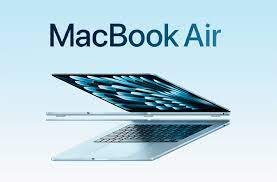The Apple MacBook Air M4 (13-inch) remains a top contender in the ultraportable laptop market, offering an impressive blend of performance, battery life, and design. Apple has continued its tradition of refining this device, and the M4 version builds on the strong foundation of its predecessors, adding substantial improvements across the board.
Performance Boost with M4 Chip
Powered by the M4 chip, the MacBook Air offers a noticeable performance increase compared to its M2 and M3 predecessors. Apple’s new M4 processor delivers enhanced speed, responsiveness, and efficiency, making it ideal for a wide range of tasks, from basic productivity to more demanding creative work. Whether you’re working on documents, browsing the web, or editing photos, the M4 handles it all with ease.
Improved Design and Build
The MacBook Air’s design remains sleek and lightweight, with a high-quality aluminum finish that makes it feel premium without being overly heavy. Despite being thin, it doesn’t compromise on ports, offering sufficient connectivity options, including a legacy 3.5mm headphone jack. The laptop’s Sky Blue color variant is also a standout, adding a bit of flair to the otherwise minimalistic design.
Battery Life and Display
One of the most significant selling points of the MacBook Air M4 is its impressive battery life. It can easily last a full workday with moderate use, making it ideal for those who need a portable device that doesn’t need constant recharging. The 13-inch display offers vibrant colors and good brightness levels, though it lags behind in terms of display technology compared to competitors featuring OLED or ProMotion technology. For most users, however, the display will be more than sufficient for everyday tasks.
Apple Ecosystem and macOS
macOS continues to provide a smooth, user-friendly experience, seamlessly integrating with other Apple devices. Whether you’re using an iPhone, iPad, or Apple Watch, the Apple ecosystem makes the MacBook Air even more attractive for those already invested in Apple’s hardware.
What Reviewers Liked
- Lower starting price compared to previous generations
- Improved performance with M4 chip over M2 and M3
- Supports two external displays with the lid open
- RAM boost even in base model
- Best-in-class touchpad experience
- Attractive Sky Blue color option
What Reviewers Didn’t Like
- Some ultraportable Windows laptops outpace it in performance
- Battery life is slightly shorter than the 2024 model
- Display tech feels outdated, especially compared to OLED screens
- Apple Intelligence remains a mixed experience
- Expensive upgrades for higher specs
- Screen is still limited to 60Hz refresh rate
- Lacks additional ports
- Notch design is still divisive
For existing Mac users, maybe you’re worried about the end of Intel Mac support, or you have an M1 Air that’s starting to show its age. If you’re a PC user, maybe the collection of minor annoyances that come with Windows 11 have you thinking about a switch. Whatever the reason, there’s almost never been a better time to be considering a MacBook Air.
Competitors and Alternatives
While the MacBook Air M4 offers great value, there are several competitors that target similar markets, including:
- Asus Zenbook A14 Copilot+ PC – A good alternative for those looking for a Windows-based ultraportable.
- Microsoft Surface Laptop 7 (2024) – A solid option for users seeking a Windows laptop with premium features.
- Apple MacBook Pro 14 M4 – A more powerful but pricier option for those who need additional performance.
Final Verdict
The MacBook Air M4 remains one of the best ultraportables available, offering a strong balance of performance, design, and price. While it may not be the ideal upgrade for those with M2 or M3 models, it’s an excellent choice for users with older Intel or M1 MacBooks. Despite some minor drawbacks, such as the aging display tech and limited ports, the M4 version continues to set the standard for lightweight laptops.
At a starting price of $999, the MacBook Air M4 represents great value, especially for users who prioritize portability, battery life, and the Apple ecosystem.


